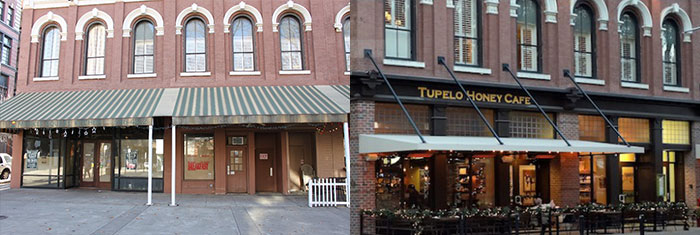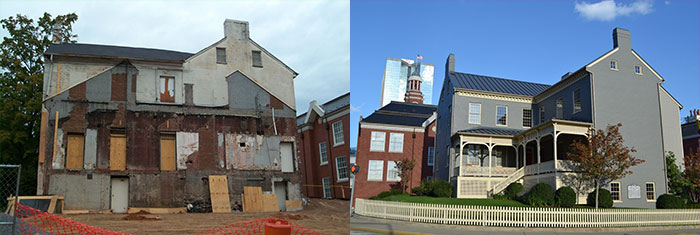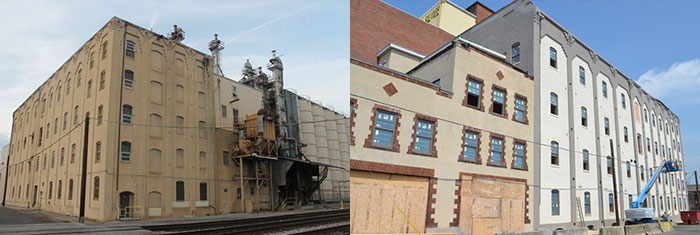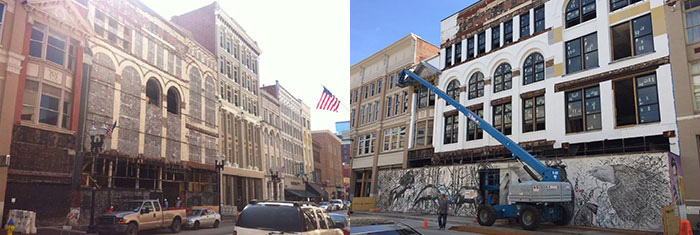The Greenest Building is One that is Already Built
Green-building is promoted as the new norm in eco-friendly construction. But preserving old buildings may be an even greener approach.
Two historic preservation events were held in Knoxville this fall, both showcasing the role of preservation in environmental stewardship.
The East Tennessee Preservation Alliance held its conference October 22-24. Donovan Rypkema, an internationally-noted urban economist, was the keynote speaker. He introduced the benefits of historic preservation, stating "it is not the solution to every urban problem, but it is part of the solution for most of them."

BEFORE/AFTER: 2 Market Square, former Kerns Bakery Building – Adaptively re-used as a restaurant
Rypkema talked about environmental benefits of adaptively reusing old buildings, offering some compelling facts. For example, researchers with the National Trust for Historic Preservation’s Green Lab found that it can take at least 10 years, and, in a lot of cases, as many as 80 years before the energy-efficient features of new buildings begin to make up for the damage their construction caused to the environment. After monitoring energy usage of a variety of building types, the Lab found that renovated older buildings nearly always result in less environmental harm than do demolition and new construction.

BEFORE/AFTER: Former James Park House - Adaptively re-used as offices for a non-profit organization
Rypkema cited a recent energy audit of New York City buildings that showed those constructed before 1930 have the least energy usage per square foot and use less energy than recently constructed buildings that incorporate energy-saving features such as waterless toilets and solar panels.
Among other Green Lab findings, costs of providing services like water, sewer, and roads are 50 to 80 percent lower for renovated historic buildings than for new buildings constructed outside of downtown areas. And for every 50,000-square foot warehouse that is rehabilitated within a downtown area, five acres of farmland are preserved.

BEFORE/AFTER: White Lily Flour Manufacturing Building - Adaptively re-used as a multi-family residential complex
The second local preservation event, the Knox Heritage Awards Celebration, was held November 19 at The Standard on West Jackson Avenue. Nationally-recognized preservationist Tom Mayes was the keynote speaker. Deputy general counsel for the National Trust for Historic Preservation, Mayes offered some thoughts on saving historic buildings. "Too often," he lamented, "old buildings are considered to be disposable."

BEFORE/AFTER: Former JC Penney Building - now houses a mix of uses including a restaurant and residential units.
Like Rypkema, Mayes provided reasons for keeping and reusing old buildings, summarizing key points from the Urban Land Institute, the Green Building Council, Smart Growth America, the Green Lab, and others. In particular, he promoted the concept of "embodied energy." Old buildings and communities retain the energy and carbon that was used to produce them—the wood and coal used to fire the bricks, smelt the tin, forge the nails, saw and transport the timber, as well as the human sweat equity. It is painfully wasteful when these materials and their embodied energy are discarded in landfills, adding to the environmental impact of demolition.
Mayes said that "keeping and using old places is the most environmentally-sound things a person or community can do—more than building or buying anything new that claims to be green." He quoted Carl Elefante of nationally-noted Quinn-Evans Architects, "the greenest building is…one that is already built."

